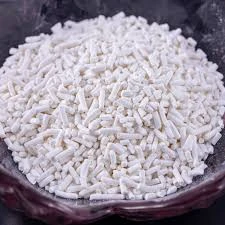
Exploring the Role of Emulsifier 481 in Enhancing Bread Quality and Texture
The Role of Emulsifier E481 in Bread Making
Bread is a staple food in many cultures around the world, loved for its versatility and ease of preparation. The quality of bread can be influenced by various ingredients and processes, one of which is the use of emulsifiers. Among these, Emulsifier E481, or sodium stearoyl lactylate, has become increasingly popular in the baking industry. This article explores the significance of E481 in bread making, its functions, and its benefits.
What is Emulsifier E481?
Sodium stearoyl lactylate, commonly referred to as E481, is an emulsifier derived from stearic acid and lactic acid. It is mainly used in the food industry to improve the texture and shelf-life of baked products. E481 is particularly favored for its ability to interact with both fats and water, promoting a more stable dough structure.
The Function of E481 in Bread
1. Improved Dough Stability One of the primary roles of E481 in bread production is to enhance dough stability. It strengthens the gluten network, allowing the dough to retain its shape during fermentation and baking. This improved stability is essential for producing high-quality bread with a good volume and texture.
2. Moisture Retention E481 helps retain moisture in the bread, resulting in a softer crumb and a longer shelf life. By reducing moisture loss, E481 can help keep bread fresh for an extended period. This is particularly beneficial for commercial bakeries that need to maintain product quality over time.
emulsifier 481 in bread

3. Texture Enhancement The emulsifying properties of E481 contribute to a desirable texture in the final product. It produces a finer crumb structure and a tender, airy loaf. This texture is often sought after by consumers, as it enhances the overall eating experience.
4. Improved Dough Handling E481 can make the dough easier to handle and process. Bakers appreciate this, as it can lead to less breakage during shaping and forming. The ease of handling can enhance production efficiency in commercial settings.
5. Fat Distribution As an emulsifier, E481 aids in the uniform distribution of fats throughout the dough. This helps in achieving an even lipid matrix, which can positively affect the flavor and overall quality of the bread.
Health and Safety Considerations
Sodium stearoyl lactylate (E481) is generally recognized as safe (GRAS) by food safety authorities in many countries, including the U.S. Food and Drug Administration (FDA). While the consumption of emulsifiers like E481 is typically considered safe, it is essential for consumers to be informed about food additives. Individuals with specific dietary restrictions or allergies should always read ingredient labels and consult with health professionals when necessary.
Conclusion
Emulsifier E481 plays a vital role in modern bread making, contributing to dough stability, texture, moisture retention, and overall product quality. Its ability to enhance the handling and processing of dough makes it an invaluable ingredient for both home bakers and commercial bakeries. As the baking industry continues to evolve, the incorporation of emulsifiers like E481 will likely remain central to producing high-quality bread that meets consumer expectations. Whether enjoyed on its own or as part of a sandwich, the impact of emulsifiers like E481 on the bread we consume is indeed significant.
-
Pure Sodium Dichloroisocyanurate Dihydrate | Powerful DisinfectantNewsAug.29,2025
-
Industrial Chemicals: Quality & Purity for Every IndustryNewsAug.28,2025
-
Nitrile Rubber Honoring Strict Production StandardsNewsAug.22,2025
-
Aspartame Ingredients Honoring Food Safety ValuesNewsAug.22,2025
-
Fertilizer for Balanced Plant NutritionNewsAug.22,2025
-
Cyanide Gold Processing with High Purity AdditivesNewsAug.22,2025
-
Formic Acid in Textile Dyeing ApplicationsNewsAug.22,2025
Hebei Tenger Chemical Technology Co., Ltd. focuses on the chemical industry and is committed to the export service of chemical raw materials.
-

view more DiethanolisopropanolamineIn the ever-growing field of chemical solutions, diethanolisopropanolamine (DEIPA) stands out as a versatile and important compound. Due to its unique chemical structure and properties, DEIPA is of interest to various industries including construction, personal care, and agriculture. -

view more TriisopropanolamineTriisopropanolamine (TIPA) alkanol amine substance, is a kind of alcohol amine compound with amino and alcohol hydroxyl, and because of its molecules contains both amino and hydroxyl. -

view more Tetramethyl Thiuram DisulfideTetramethyl thiuram disulfide, also known as TMTD, is a white to light-yellow powder with a distinct sulfur-like odor. It is soluble in organic solvents such as benzene, acetone, and ethyl acetate, making it highly versatile for use in different formulations. TMTD is known for its excellent vulcanization acceleration properties, which makes it a key ingredient in the production of rubber products. Additionally, it acts as an effective fungicide and bactericide, making it valuable in agricultural applications. Its high purity and stability ensure consistent performance, making it a preferred choice for manufacturers across various industries.





